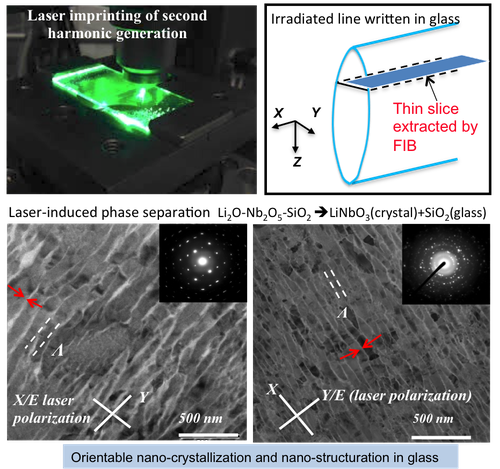Creation and orientation of nanocrystals by femtosecond laser for controlling the optical non-linear response in silica-based glasses
with the contribution of : Jing Cao, François Brisset
Due to random disorder, a glass exhibits inversion symmetry such that second harmonic generation (SHG) is forbidden. However, by irradiation with a tightly focused femtosecond (fs) laser, it is possible to induce nonlinear optical crystal precipitation, in order to break the inversion symmetry and thus to induce SHG. Moreover, this can be achieved locally in three dimensions.
For demonstration, we applied the procedure described below in the glass system Li2O-Nb2O5-SiO2 that allows the formation of LiNbO3 crystal, a highly nonlinear optical one. The procedure is thus the following:
1) adjustment of the glass chemical composition for obtaining a glass sensitive enough to fs laser.
2) control of the laser parameters (pulse duration, pulse repetition rate, speed of beam scanning, pulse energy…) for obtaining nanocrystals with correct space distribution and size. In addition, the size of the affected zone has to be limited.
3) control of the orientation of the nanocrystals. We show that it is possible to fulfill this condition by controlling the laser polarization orientation. This has been achieved by electron backscatter diffraction method (EBSD). In other words, this process can be controlled with light directly.

In addition, energy dispersive X-ray spectroscopy coupled to scanning transmission electron microscopy (STEM/EDS) and transmission electron microscopy revealed an orientable microstructure similar to the one called nanogratings form in silica. The originality here is a textured nonlinear optical nanocrystals embedded in a network of “walls” made of vitreous phase, aligned perpendicular to the laser polarization direction. It results that birefringence and nonlinear optical property can be mastered in the same time. This is a highly valuable aspect of the work.
These findings highlight spectacular modifications of glass by fs laser radiation. With further improvements in the fabrication techniques, the application of this work is to achieve SHG waveguides, electro-optics waveguides and birefringence-based devices.

